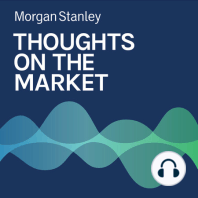3 min listen

Jonathan Garner: What's Next for Asia and Emerging Markets?
Jonathan Garner: What's Next for Asia and Emerging Markets?
ratings:
Length:
4 minutes
Released:
Aug 24, 2022
Format:
Podcast episode
Description
As Asia and EM equities continue to experience what may end up being the longest bear market in the history of the asset class, looking to past bear markets may give investors some insight into when to come off the sidelines.-----Transcript-----Welcome to Thoughts on the Market. I'm Jonathan Garner, Chief Asia and Emerging Market Equity Strategist at Morgan Stanley. Along with my colleagues, bringing you a variety of perspectives, today I'll be discussing whether we're nearing the end of the current bear market in Asia and emerging market equities. It's Wednesday, August the 24th, at 8 a.m. in Singapore. The ongoing bear market in Asia and EM equities is the 11th which I've covered as a strategist. And in this episode I want to talk about some lessons I've learned from those prior experiences, and indeed how close we may be to the end of this current bear market. A first key point to make is that this is already the second longest in duration of the 11 bear markets I've covered. Only that which began with the puncturing of the dot com bubble by a Fed hike cycle in February 2000 was longer. This is already a major bear market by historical standards. My first experience of bear markets was one of the most famous, that which took place from July 1997 to September 1998 and became known as the Asian Financial Crisis. That lasted for 518 days, with a peak to trough decline of 59%. And as with so many others, the trigger was a tightening of U.S. monetary policy at the end of 1996 and a stronger U.S. dollar. That bear market ended only when the U.S. Federal Reserve did three interest rate cuts in quick succession at the end of 1998 in response to the long term capital management and Russia defaults. Indeed, a change in U.S. monetary policy and/or a peak in the U.S. dollar have tended to be crucial in marking the troughs in Asia and EM equity bear markets. And that includes the two bear markets prior to the current one, which ended in March 2020 and October 2018. However, changes in Chinese monetary policy and China's growth cycles, starting with the bear market ending in October 2008, have been of increasing importance in recent cycles. Indeed, easier policy in China in late 2008 preceded a turn in U.S. monetary policy and helped Asia and EM equities lead the recovery in global markets after the global financial crisis. Although China has been easing policy for almost a year thus far, the degree of easing as measured by M2 growth or overall lending growth is smaller than in prior cycles. And at least in part, that's because China is attempting to pull off the difficult feat of restructuring its vast and highly leveraged property sector, whilst also pursuing a strategy of COVID containment involving closed loop production and episodic consumer lockdowns. Those key differences are amongst a number of factors which have led us to recommend staying on the sidelines this year, both in our overall coverage in Asia and emerging markets, but also with respect to China. We have preferred Japan, and parts of ASEAN, the Middle East and Latin America. Finally, as we look ahead I would also note that one feature of being later on in a bear market is a sudden fall in commodity prices. And certainly from mid-June there have been quite material declines in copper, iron ore and more recently, the oil price. Meanwhile, classic defensive sectors are outperforming. And that sort of late cycle behavior within the index itself raises the question of whether by year end Asia and EM equities could once again transition to offering an interesting early cycle cyclical play. That more positive scenario for next year would depend on global and U.S. headline inflation starting to fall back, whether we would see a peak in the U.S. dollar and Fed rate hike pricing.For the time being, though, as the clock ticks down to the current bear market becoming the longest in the history of the asset class, we still think patience will be rewarded a while longer. Thanks for
Released:
Aug 24, 2022
Format:
Podcast episode
Titles in the series (100)
Andrew Sheets: For Markets, Signs, Signs, Everywhere Signs by Thoughts on the Market